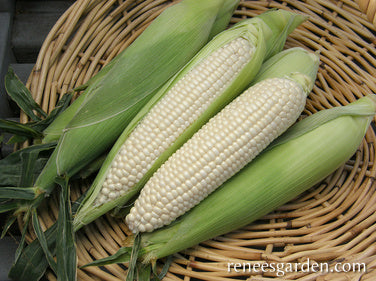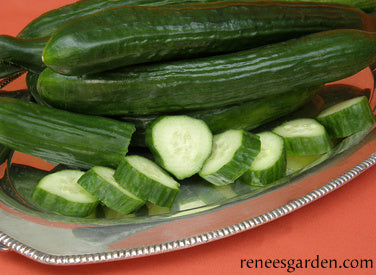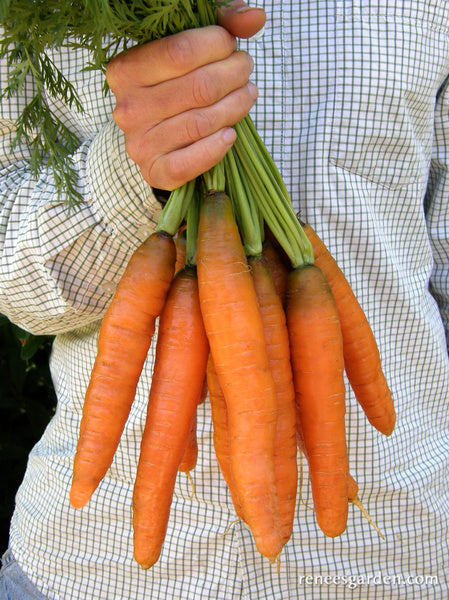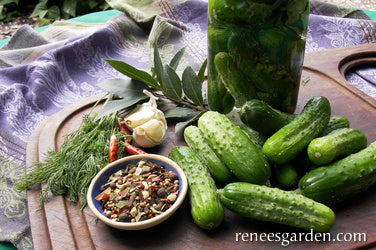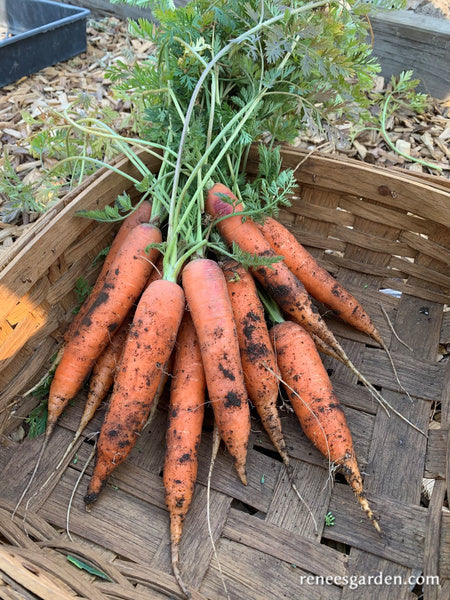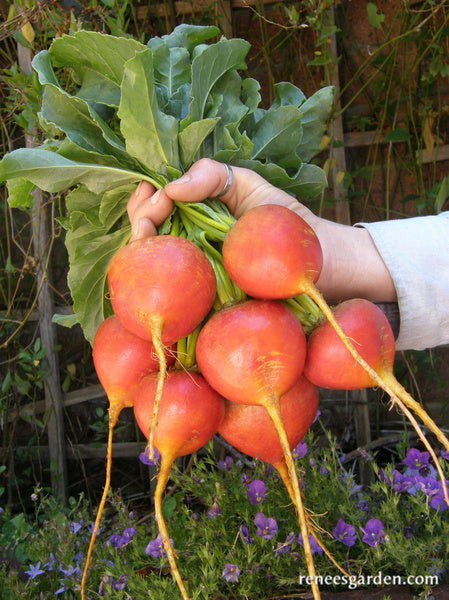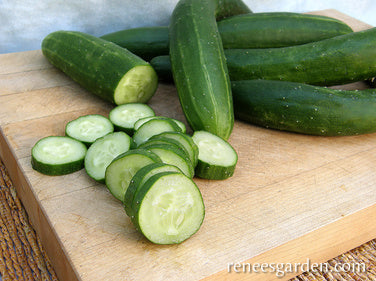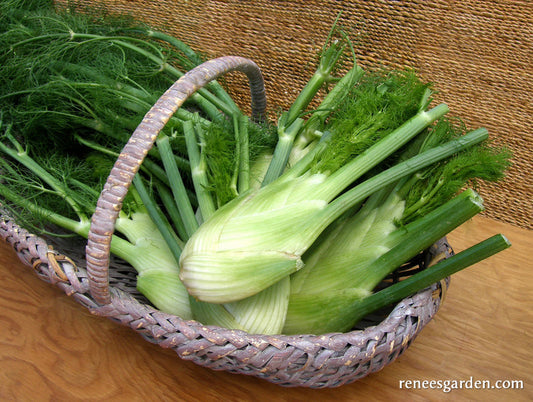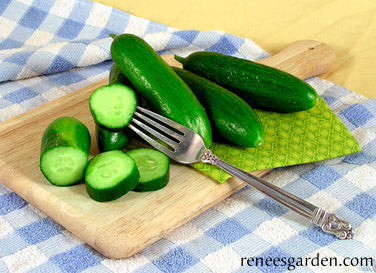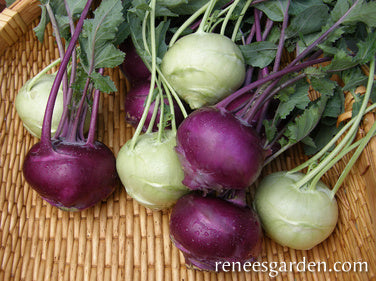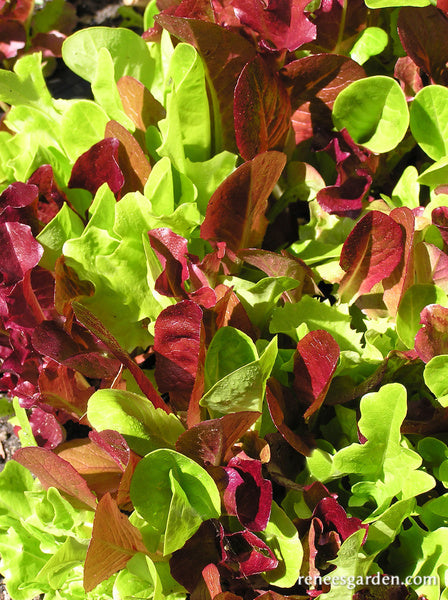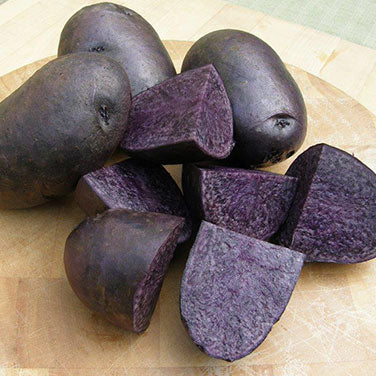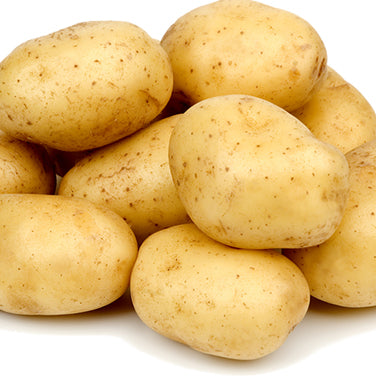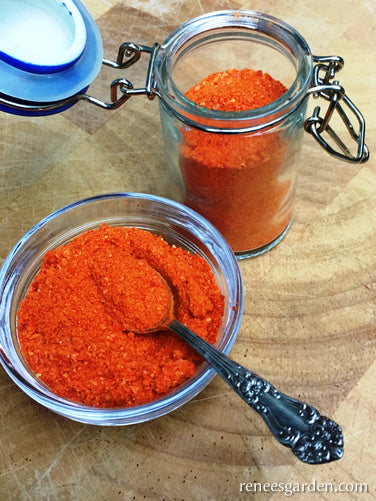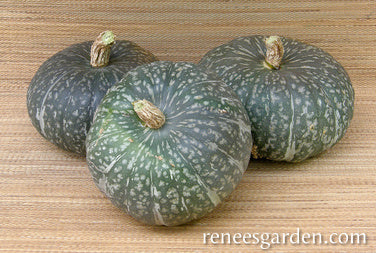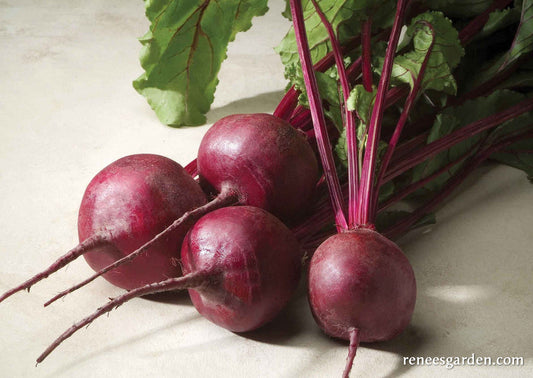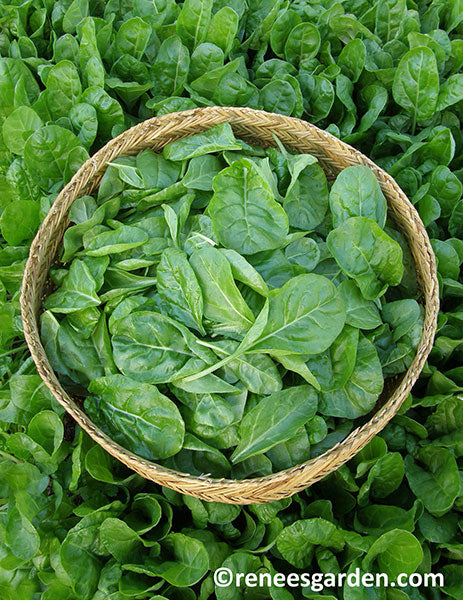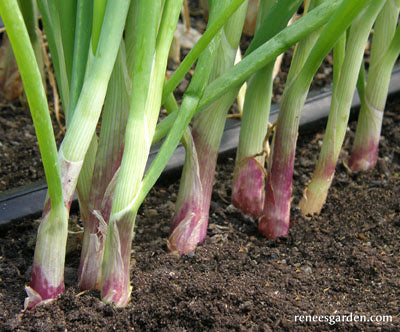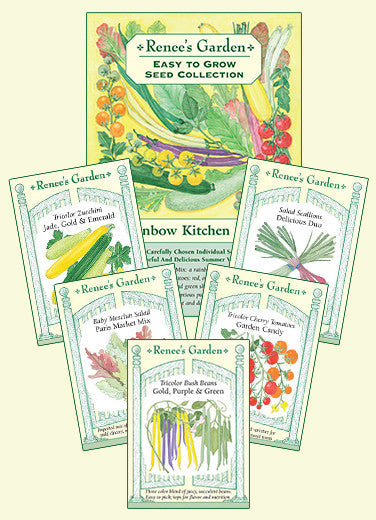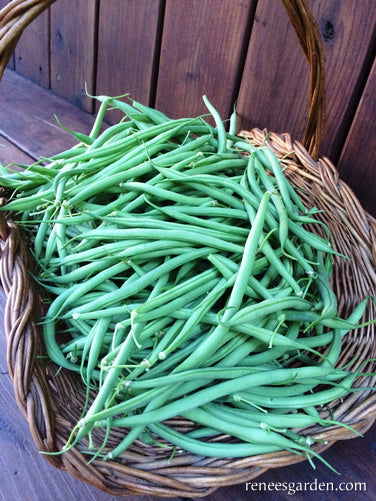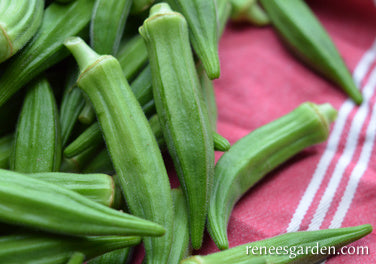Vegetables
Set The Table From Your Garden
-
White Corn Sugar Pearl
START SEEDS OUTDOORS
In spring, once weather is warm and settled and night temperatures stay securely above 55°F (13°C), plant seeds in well-worked, fertile soil in full sun. Poke seeds in 1 inch deep and 4 to 6 inches apart. Plant in a block of 4 side-by-side rows, each row at least 1 foot apart. Thin seedlings to 1 foot apart when several inches tall. Protect from marauding birds if necessary. If first sowing doesn’t germinate evenly, replant right away as new seedlings catch up quickly. Make several sowings 2 or 3 weeks apart until early June to have successive harvests.
GROWING NOTES
There is no need to isolate Sugar Pearl from other varieties, but plant seeds in blocks of at least 4 parallel rows to ensure good wind pollination and well filled out ears. Corn is a heavy feeder, so add plenty of compost or aged manure to the soil at sowing time, and then fertilize when young plants are 7 to 8 inches tall and again as ears begin to form.
HARVEST AND USE
Well filled out ears of corn are ready to eat when the silks are very dark brown but not dried out. Test by choosing a plump ear and peeling back the husk very slightly. The kernels should be tender and milky when slit with a fingernail. Sugar Pearl is a SE corn, so the tender crisp kernels will hold their sweetness after harvest.
Regular price $4.99Sale price $4.99Unit price / per -
English Cucumber Chelsea Prize
START SEEDS OUTDOORS
Plant heat loving cucumbers only when weather is warm and settled and night temperatures stay above 50°F (13°C). Amend soil well with aged manure or compost. Sow groups of 2 to 3 seeds 1 1/2 feet apart and 1 inch deep with 3 feet between rows. Thin to 1 seedling per group. Or make slightly mounded hills 5 feet apart, sowing 5 or 6 seeds in each hill. Thin to the 3 strongest plants.
GROWING NOTES
Protect seedlings from marauding birds with plastic berry baskets, removing before plants get crowded. Shallow rooted cucumbers need ample and consistent moisture. Avoid overly wet or dry periods for good quality fruit. Growing cucumber vines up vertical supports gives you long straight fruits and saves garden space.
HARVEST AND USE
Cut rather than pull fruits from vines before seeds are large inside. Harvest every few days for longest fruit production. These juicy tender cucumbers need no peeling. Slice and enjoy for refreshing snacks, in salads and sandwiches. Eat cucumbers within a day or two of picking for best taste and quality.
Regular price $4.99Sale price $4.99Unit price / per -
Nantes Carrots Yaya
START SEEDS OUTDOORS
In spring once danger of hard frost is past, sow seeds in full sun in finely worked, fertile soil. Sow 1/4 inch deep and 1/2 inch apart in rows 8 inches apart, or broadcast thinly in beds and cover lightly. Keep seedbed evenly moist as carrots can be slow to germinate, emerging over 10 to 20 days. If first sowing comes up unevenly, replant right away as seedlings catch up quickly. Be sure to thin young carrots several times so seedlings are about 2 inches apart and have room to size up.
GROWING NOTES
Carrots like well-worked soil and need consistent moisture to grow well. If your soil tends to dry out, cover seedbed with floating row cover or burlap to help retain moisture during the germination period and water right through it. Keep carrots well watered and thinned. For a late season crop, sow again 3 months before first expected frost.
HARVEST AND USE
Let young carrots size up and color fully to orange before harvesting for best flavor. Sauté or steam just until tender crisp and serve with a squeeze of fresh lemon or lime juice, sweet butter and fresh dill; or try buttered and glazed with a little maple syrup or honey.
Regular price $4.89Sale price $4.89Unit price / per -
Pickling Cucumber Endeavor
START SEEDS OUTDOORS
Plant heat loving cucumbers only when weather is warm and settled and night temperatures stay above 50°F (10°C). Amend soil well with aged manure or compost. Sow groups of 2 to 3 seeds 1 1/2 feet apart and 1 inch deep with 3 feet between rows.
Thin to 1 seedling per group. Or make slightly mounded hills 5 feet apart, sowing 5 or 6 seeds in each hill. Thin to the 3 strongest plants.
GROWING NOTES
Protect seedlings from marauding birds with plastic berry baskets, removing before plants get crowded. Shallow rooted cucumbers need ample and consistent moisture. Avoid overly wet or dry periods for good quality fruit. Growing cucumber vines up vertical supports gives you long straight fruits, saves garden space and makes them easy to harvest.
HARVEST AND USE
Cut rather than pull fruits from vines when 3 to 4 inches long. Harvest often: every few days for longest fruit production and so cucumbers don’t get too big on the vine. Try to put up pickles very soon after harvesting for best results. Enjoy some Endeavor cucumbers fresh picked from the garden, sliced up with tomatoes and chopped dill or chives with olive oil and a pinch of salt.
Regular price $3.69Sale price $3.69Unit price / per -
Crispy French Carrots Bolero Nantes
START SEEDS OUTDOORS
In spring once danger of hard frost is past, sow seeds in full sun in finely-worked, fertile soil. Sow 1/4 inch deep and 1/2 inch apart in rows 8 inches apart, or broadcast thinly in beds and cover lightly. Keep seed bed evenly moist as carrots can be slow to germinate, emerging over 10 to 21 days. If first sowing comes up unevenly, replant right away as seedlings catch up quickly. Thin young carrots several times so seedlings are 2 to 3 inches apart and have room to size up.
GROWING NOTES
Carrots like well-worked soil and need consistent moisture to grow well. If your soil dries out fast, cover seedbed with floating row covers to help retain moisture during the germination period. Keep carrots well weeded throughout the growing season. Plant again 3 months before first expected fall frost for a late crop.
HARVEST AND USE
Let carrots color up to deep orange before harvesting for best sweet flavor. Eat fresh, juice, or lightly steam. Set off their flavor with fresh lemon or orange juice and a sprinkling of minced herbs. Or glaze with a little honey and ginger or cinnamon. Fresh mint leaves are a tasty, pretty garnish for fresh garden carrots.
Regular price $3.99Sale price $3.99Unit price / per -
Gourmet Beets Golden
START SEEDS DIRECTLY OUTDOORS
In early spring, when danger of hard frost is over, sow seeds in well-worked, fertile soil in full sun. Space seeds 1 inch apart in rows 8 to 10 inches apart, or broadcast evenly for bed planting. Firming soil well over these irregularly shaped seeds will ensure best germination. If first sowing comes up unevenly, sow more seeds as seedlings will catch up fast. When large enough, carefully thin seedlings to 3 to 4 inches apart so growing beets have room to size up.
GROWING NOTES
For best quality, tender roots, sow seeds before midsummer heat and again in late summer to early fall—in cold climates, allow at least 10 weeks before fall frosts. Keep soil evenly moist throughout the season. Be sure to thin seedlings several times when plants are small, as beets grow best if given enough room.
HARVEST AND USE
After thinning seedlings, use tender young tops for nutritious, flavorful steamed greens. Harvest baby beets at 1 to 2 inches in diameter, or let roots grow as large as desired. Garden fresh beets cook quickly. They are delicious steamed, boiled or baked whole in their skins like potatoes, then peeled for wonderful color and sweet concentrated flavor. Golden color does not “bleed” like red beets.
Regular price $3.99Sale price $3.99Unit price / per -
Signature Salads Crispy Winter Greens
START SEEDS OUTDOORS
At midsummer, or early fall in mild climates, sow seeds in a sunny garden bed 1/4 inch deep and 1 to 2 inches apart in rows 12 inches apart. Or, if it is still over 80°F (27°C) at sowing time, sow seeds in containers in a spot out of direct sun, but with bright light all day. Tend carefully and keep evenly moist. When seedlings are a few inches tall with several sets of leaves, transplant into the garden a foot apart. Gradually thin directly sown seedlings to stand 1 foot apart to allow heads room to mature.
GROWING NOTES
Savor earliest thinnings in fall salads. Cool weather will bring vigorous growth. These tasty greens tolerate cold weather and light frosts well but require consistent moisture. Weed, water and thin carefully and feed monthly for best quality salad heads.
HARVEST AND USE
Radicchio is best harvested when red heads have formed inside the outer green “wrapper” leaves. Pick entire heavy rosettes of escarole and curly endive. Cut up and enjoy these hearty salads with either simple vinaigrettes or rich, creamy dressings. Try tossed with cooked chicken, meat or cubed cheese and olives for delicious whole meal salads. Add toasted nuts and cubed apples or pears for a delicious flavor contrast.
Regular price $3.69Sale price $3.69Unit price / per -
Japanese Cucumber Tasty Green
START SEEDS OUTDOORS
Plant heat-loving cucumbers in full sun only after spring weather is warm and settled and night temps stay above 50°F (10°C). Amend soil well with aged manure or compost. Sow in groups of 2 to 3 seeds 18 in. apart and 1 in. deep. When the baby seedlings are 2 in. tall, thin out extras, leaving one strong seedling per group.
After thinning, put 4-5 ft. strong vertical supports or individual tomato cages around each seedling and train vines up supports as they grow. This approach makes it easier to harvest straight fruits, saves garden space, and helps prevent disease.
GROWING NOTES
Protect seedlings from marauding birds with plastic berry baskets, removing before plants get crowded. Shallow-rooted cucumbers need adequate and consistent moisture to produce sweet tasting, nicely formed cucumbers. Avoid overly wet or dry periods for good quality fruits.
HARVEST AND USE
Cut rather than pull fruits from vines before seeds are large inside. Harvest every few days for longest fruit production. These juicy tender cucumbers need no peeling. Slice and enjoy for refreshing snacks, in salads and sandwiches. Eat cucumbers within a day or two of picking for best taste and quality.
Regular price $4.69Sale price $4.69Unit price / per -
Heirloom Bulbing Fennel Romanesco
STARTING SEEDLINGS
In early spring when danger of hard frost is over, sow seeds in well-worked, fertile soil in full sun. Space seeds 4 inches apart in rows 12 inches apart and cover seed 1/2 inch deep. Carefully thin when seedlings are large enough to handle to stand 10 to 12 inches apart so bulbs have room to grow and mature. Or start seeds indoors in a container of seed starting mix. Keep moist and provide a strong light source until seedlings are 3 or 4 inches tall and ready to transplant as above.
GROWING NOTES
For tender, best quality bulbs, fennel needs rich soil and cool growing weather, so sow seeds as early as the ground can be worked and again in midsummer for fall harvesting. Be sure seedlings are thinned or transplanted 10 to 12 inches apart. Keep plants evenly moist throughout the growing season – mulching is a good strategy. Fennel is a heavy feeder, so fertilize every 2 to 3 weeks with a high nitrogen fertilizer such as fish emulsion.
HARVEST AND USE
When bulbs are full and plump, cut them off at soil level. Trim the feathery leaves down to the solid base. Slice the crispy bulbs and add to salads, or eat with dips, or grill or sauté. The leafy tops are a great seasoning for seafood, especially salmon. Fennel’s flavor is like sweet anise/ celery that becomes deeper and richer with cooking.
Regular price $4.89Sale price $4.89Unit price / per -
Persian Baby Cucumbers Green Fingers
START SEEDS OUTDOORS
Plant heat-loving cucumbers in full sun only when weather is warm and settled and night temps stay above 50°F (10°C), first amending soil well with aged manure or compost. Sow groups of 2 to 3 seeds, 1 inch deep and 18 inches apart. When the baby seedlings are 2 inches tall, thin out extras, leaving one strong seedling per group. After thinning, provide a 3 to 5 foot strong vertical support or tomato cage around each seedling and train the vines up the supports as they grow. Growing vigorous, heavy-bearing cucumber vines up supports makes it easier to harvest the cucumbers, saves garden space, and helps prevent disease.
GROWING NOTES
Protect seedlings from marauding birds with plastic berry baskets, removing before plants get crowded. Shallow-rooted cucumbers need adequate and consistent moisture to produce sweet tasting, nicely formed cucumbers. Avoid overly wet or dry periods for good quality fruits.
HARVEST AND USE
Our baby cucumbers begin bearing fruit early. For best quality, cut rather than pull cucumbers from the vine when 3 to 5 inches long. They need no peeling, just slice and enjoy their crisp texture and flavor. Enjoy in a Mediterranean salad of sliced Green Fingers combined with very fresh plain whole yogurt, a little good olive oil, finely minced garlic and freshly chopped dill.
Regular price $4.99Sale price $4.99Unit price / per -
Triple-Curled Kale Dutch Darkibor
TO START DIRECTLY IN THE GARDEN
As soon as ground can be worked in spring, prepare a well-drained, fertile garden bed in full sun. Sow seeds 2 inches apart in rows 12 to 18 inches apart. Cover 1/2 inch deep and keep soil evenly moist to ensure good germination. Sow again in late summer for another cold-hardy crop.
TO START INDOORS
Sow seeds in a container of seed starting mix 2 inches apart and cover 1/2 inch deep. Keep moist and provide a strong light source until seedlings are 3 to 4 inches tall then plant outdoors. Space 10 to 12 inches apart so plants have room to mature.
GROWING NOTES
Kale tastes best in cool weather so sow spring crops early. A crop sown in late summer will yield through fall and winter except in the coldest climates. Frost actually enhances kale leaves’ color, flavor and sweetness. Mulch to retain moisture in summer and before the ground freezes to protect the roots of fall crops.
HARVEST AND USE
Begin harvesting outer leaves when plants have 6 to 8 leaves. Vitamin-rich kale is delicious in hearty winter soups, stews and sautés; or braise the beautiful leaves with garlic and olive oil in traditional Mediterranean style. Pull and discard once plants begin to bloom since the leaves of flowering stalks get tough and bitter.
Regular price $3.99Sale price $3.99Unit price / per -
Gourmet Kohlrabi Crispy Colors Duo
TO START SEEDS DIRECTLY IN THE GARDEN
In early spring, as soon as ground can be worked, plant in well-drained, fertile soil in full sun. Sow seeds 1 inch apart in rows 6 to 8 inches apart. Cover 1/2 inch deep and keep soil evenly moist for good germination. When seedlings are 3 inches tall, thin to stand 4 to 6 inches apart, ensuring that the bulbs have enough room to grow rapidly. Sow again in late summer for another crop.
TO START EARLY INDOORS
Start seeds 4 to 5 weeks before last expected spring frost. Sow 1 inch apart in a container of seed starting mix, cover 1/2 inch deep and keep evenly moist. Provide a strong light source until ready to plant out. When 3 inches tall, transplant seedlings 4 to 6 inches apart into rich, well-drained soil in full sun.
GROWING AND HARVEST
Plant in rich fertile soil. Fertilize regularly and water consistently to ensure the steady growth that produces the best tasting, sweetest kohlrabi. Harvest when bulbs are about 2 to 3 inches in diameter. Peel, slice and enjoy their crisp flesh raw or cook and serve mashed with butter, in soup or with a cream sauce.
Regular price $3.99Sale price $3.99Unit price / per -
Farmers Market Lettuce Blend Sweet Greens & Reds
START SEEDS OUTDOORS
In cool early spring weather, sow seeds in finely worked soil in full sun. Shake seeds from the palm of your hand, broadcasting them about 1/2 inch apart over the entire seedbed or in wide rows, and cover lightly and evenly with 1/4 inch of fine soil. Firm soil gently and water with a fine spray. Keep seedbed evenly moist. Make small successive sowings until summer weather turns hot for a constant supply. Plant again in late summer for fall harvesting.
GROWING NOTES
Mixed lettuces thrive in mild weather with consistent moisture. To extend the sowing season into hot weather, sow in light shade or erect a canopy of loosely woven shade cloth over the bed. Birds are often attracted to tender young seedlings, so protect them if necessary.
HARVEST AND USE
To harvest by the “cut and come again” method, wait until plants are 4 or 5 inches tall. Cut as much lettuce as you need, using scissors to shear off a patch of leaves 1 to 2 inches above the soil level. Water well and fertilize lightly and plants will regrow for several more cuttings. Dress with a simple vinaigrette to enjoy the sweet flavor and juicy texture of these delicate young leaves at their best.
Regular price $2.99Sale price $2.99Unit price / per -
Heirloom Purple Majesty
Purple Majesty potatoes are oval with purple/blue flesh. They have much better flavor than other blue varieties and keep their rich color when cooked. The natural deep purple/blue pigment is due to very high levels of anthocyanin and carotenoids, potent bioactive antioxidants that help reduce the risk of heart disease. Pigmented potatoes like Purple Majesty have been linked to decreased oxidative stress, inflammation, and improved immune status.
Besides real health benefits, Purple Majesty potatoes offer excellent table quality with firm moist flesh and great flavor whether baked, boiled or fried. Use them for a show stopping potato salad decorated with colorful herb blossoms. For a real stunner, serve a plate of steamed potato slices alternating deep colored Purple Majesty with beautiful Terra Rosa, our red-fleshed variety.Midseason: 85-95 days / Type: Indeterminate
1 lb. bag (plants a 10 foot row)
Mix and match your own potato patch:
Save 10% when you buy any 3 varieties or more!
Discount taken at checkoutRegular price $19.95Sale price $19.95Unit price / per -
Heirloom German Butterball
Always a customer favorite! Heirloom German Butterball potatoes have slightly flaky, but never dry, butter-yellow flesh and golden, netted smooth skin. They are our first choice for potato salads; when cooked till tender, they hold together and don’t fall apart like many other potatoes. They are also perfect for making hashbrowns, simple steaming or mouthwatering baked potatoes.
These great tasting medium oval-shaped potatoes are the most versatile for every kind of preparation. It is no surprise that Heirloom German Butterball won first place in Rodale’s Organic Gardening magazine’s “Taste Off.” The strong growing plants have high tuber set, with good disease resistance. You’ll have an abundant harvest of tubers that store very well.
Late-season: 95-120 days / Type: Indeterminate
1 lb. bag (plants a 10 foot row)
Mix and match your own potato patch:
Save 10% when you buy any 3 varieties or more!
Discount taken at checkoutRegular price $19.95Sale price $19.95Unit price / per -
Five Color Radish Mix Garden Party
START SEEDS OUTDOORS
In early spring as soon as ground can be worked, sow radish seeds in well-worked, fertile soil in full sun. Space seeds 1 inch apart in wide rows 6 inches apart. Keep soil evenly moist and well weeded. If first sowing comes up unevenly, replant right away. Sow in late summer for a fall crop.
GROWING NOTES
Sow this quick cool season crop wherever you intend to plant heat lovers later. Radishes thrive with crisp flesh and mild flavor when given consistent moisture. Sow small amounts a week apart to mature in warm but not hot weather. Thin quick-growing seedlings early to 2 inches apart so roots have room to size up. Protect radishes with floating row covers if marauding birds or flea beetles that chew holes in the leaves are a problem.
HARVEST AND USE
Pull radishes when young round roots have reached the size of large marbles. If weather turns hot, harvest, cut off tops and store in fridge. Radish flavor is mildest in cool weather, spicier in hot conditions. Picked young and tender, this appealing five color mix makes crispy snacks, attractive appetizers, and adds flavor and crunchy texture to salads. Especially delicious sliced and tossed with a sesame or miso flavored dressing.
Regular price $3.99Sale price $3.99Unit price / per -
Paprika Pepper Hungarian Magyar
STARTING SEEDLINGS
In early spring, start indoors about 6-8 weeks before nights stay reliably 50-55°F (10-13°C). Sow seeds 1/4 inch deep and 1 inch apart in seed starting mix. Keep moist but not soggy, and very warm 80°F (27°C). Provide a strong light source until seedlings are ready to plant outside. When seedlings are 2 inches tall, transplant into 4-inch pots. Keep at 70-75°F (21-24°C). Feed with half-strength fertilizer every week until weather is warm enough to acclimate seedlings to outdoor conditions. Transplant 2 feet apart into rich soil in full sun.
GROWING NOTES
Paprika peppers need warm conditions. Don’t transplant outdoors until nights stay above 55°F (13°C). Prepare soil well with aged manure or compost. Plant only robust seedlings with well-developed roots. Mulch plants to maintain even soil moisture. Keep well weeded, watered and fertilized.
HARVEST AND USE
Cut ripe peppers from the plants when completely red. Slit peppers open, discard seeds and cores and slice in several pieces. Dehydrate pieces until very dry and crisp. Then grind or crush into a coarse spice powder and store in glass jars to use and enjoy liberally. Tightly sealed, home-grown paprika spice powder also freezes well, retaining its wonderful rich flavor.
Regular price $4.39Sale price $4.39Unit price / per -
Kabocha Winter Squash Kurin
BEST TO START OUTDOORS
Long keeping winter squash needs full sun, rich fertile soil and warm temperatures. Wait to plant until nights are comfortably above 50°F (10°C) both day and night. Sow groups of 2 to 3 seeds 2 ft. apart and 1 in. deep in rows 4 ft. apart. Thin to 1 strong seedling per group to give vines room to ramble or climb. Or make slightly mounded hills 2 to 3 ft. across and 6 ft. apart and plant 4 to 5 seeds in each hill. When seedlings have several sets of leaves, thin to the strongest 3 seedlings per hill.
GROWING NOTES
Protect young seedlings from marauding birds by covering with plastic berry baskets at sowing time, removing before plants get crowded. To save space,vines can be trained up fences, trellises or tepees.
HARVEST AND USE
Winter squashes need to mature properly, so don’t harvest until vines have died back and squashes’ exterior rinds are fully dark green and tough enough to resist piercing with a fingernail. Then cut squashes from vines, leaving a good stem handle. Cure in the sun for about 10 days, before storing in a cool dry place where they will keep for months. To prepare, cut squash in half and bake until tender. Flesh is tender, nutty, sweet and totally delicious.
Regular price $4.99Sale price $4.99Unit price / per -
Roasting Beets Sweet Merlin
START SEEDS OUTDOORS
In early spring, when danger of hard frost is over, sow seeds in well-worked, fertile soil in full sun. Sow seeds 1 inch apart and 1/2 inch deep in rows 8 inches apart, or broadcast thinly for bed planting. Firm soil well over these irregularly shaped seeds to ensure good germination.
If first sowing germinates unevenly, plant more seed as seedlings will catch up fast. Carefully thin young seedlings to 3-4 inches apart so individual beets have room to size up.
GROWING NOTES
For best quality beets, sow seeds before midsummer heat and again in early fall. Keep soil evenly moist throughout the growing season. Be sure to thin beet seedlings carefully several times as they grow best when given enough room.
HAREVST AND USE
Harvest mature beets when at least several inches in diameter or size them up even bigger. Cut off the tops and reserve. Wash the roots, wrap in foil and then roast to perfection in a preheated 350° F oven until tender when pierced—takes at least an hour, depending on your oven. Cool, peel, slice and enjoy with butter and chopped fresh herbs. Or simply peel, slice and add roasted beets to salads. Steam the tender beet tops for tasty and nutritious greens.
Regular price $4.39Sale price $4.39Unit price / per -
Tender Chard Special Baby Leaf
BEST TO START DIRECTLY OUTDOORS
Beginning in early spring, sow seeds in finely worked soil in full sun. Shake seeds loosely from your hand, broadcasting about 1 inch apart over the entire seedbed or in wide rows, and cover lightly and evenly with 1/4 to 1/2 inch of fine soil. Firm soil gently and water in with a fine spray, then keep seedbed evenly moist. For a constant supply, makes successive sowings every three weeks until summer weather turns really hot. Plant again in late summer for fall harvesting.
GROWING NOTES
For best flavor, baby leaf chard needs consistent moisture and mild weather. Birds love tender young seedlings,so protect them as necessary with netting or floating row covers. This attractive edible will also grow well in pots at least 18 to 20 in. across to snip as needed for salads or stirfry.
HARVEST AND USE
To harvest by the “cut and come again” method: when plants are 4 to 5 in. tall, cut as much as you need, by using scissors to shear off leaves 1 to 2 in. above the soil level. Water well and fertilize lightly and plants will regrow for several more cuttings. These tender, crisp and juicy baby leaves are delicious in fresh salads. Or stirfry, braise or sauté very quickly for healthy, tasty greens.
Regular price $3.69Sale price $3.69Unit price / per -
Heirloom Salad Onions Italian Scallion
EASIEST TO START OUTDOORS
Plant seeds throughout cool spring weather and again in mid to late summer for fall harvests. Sow seeds in well-worked, fertile soil in full sun, spacing 1 inch apart in rows 8-10 inches apart, or broadcast thinly for bed planting. Plant 1/4 inch deep and firm soil well over seeds. Keep soil evenly moist while awaiting germination. Thin young seedlings to 2 inches apart, and enjoy the tender thinnings in spring salads.
GROWING NOTES
These baby salad onions take up little garden space, so tuck a row around beds of lettuce, spinach or radishes. Make several plantings a month apart to have a constant supply for spring and summer meals. Prepare soil well with lots of aged manure or compost before planting. Keep evenly moist and weed carefully when plants are young. Mulch well to conserve soil moisture and suppress weed growth.
HARVEST AND USE
To get the most out of your crop, use tender, mild-flavored early thinnings in salads. Continue thinning out seedlings gradually so plants stand an inch or two apart. Harvest as needed when the stems are ¼ to ½ inch in diameter and the tiny immature bulbs reach just 1/2 to 1 inch in diameter. Crunchy, full-flavored Italian baby salad onions are especially delicious in any green or potato salad, or in any recipe that calls for scallions or mild tasting onions.
Regular price $2.99Sale price $2.99Unit price / per -
Easy To Grow Collection The Rainbow Kitchen Vegetable Garden
Includes:
- Farmer's Market Lettuce Blend: a rainbow of colors and textures
- Garden Candy Cherry Tomatoes: red, orange, yellow and sweet as sugar
- Delicious Duo Scallions: red and green skinned, savory and crisp
- Tricolor Bush Beans: scrumptious purple, yellow and green pods
- Tricolor Zucchini: gold, light and dark green, with buttery flavor
Enjoy A Rainbow Of Vegetables In Your Garden
Enjoy a beautiful summer garden featuring delicious vegetables in a rainbow of colors and crispy, fresh-from-the-garden salads in a gorgeous range of colors, textures and shapes. Our Collection includes five unique Rainbow Vegetable packets, each containing several different colored varieties of the same vegetable. You’ll have crunchy purple, green and yellow bush beans, golden-yellow, pastel and jade green zucchini, vines with sweet sunny yellow, rich orange or bright red cherry tomatoes, both green and red skinned salad scallions and crispy lettuces in a range of pretty reds and greens.
Rainbow Vegetables Are Healthy And DeliciousPlanting these richly colored vegetables gives you a beautiful garden whose harvests will add savor and excitement to everyday meals. Plus, the more different colored vegetables you eat, the more nutritious, cancer-fighting and skin-beautifying antioxidants you’ll be incorporating into your diet. It’s easy to gain all the benefits when you grow these tasty and easy-to-grow varieties which have been carefully chosen from all over the world.
We Make It Easy To Grow Your Rainbow VegetablesSeeds for each different colored variety are packed together in one packet: in the cherry tomato and zucchini packets, the seeds for each variety are tinted with edible food dye so you can choose how many of each one to plant. The packets of multicolored beans, scallions, and lettuce seeds are each blended in an equal color mix. You’ll find our packet backs offer clear and complete growing instructions for each variety, ensuring success for anyone new to growing a vegetable garden, as well as harvest tips and cooking ideas.
Regular price $16.95Sale price $16.95Unit price / per -
Bush Bean Castandel The 'Weekend Bean'
START SEEDS OUTDOORS
In spring, once weather is warm and settled and night temperatures stay above 55°F (13°C), plant seeds in well-worked, fertile soil in full sun. Poke seeds in 1 inch deep and 3 to 4 inches apart in rows 1½ feet apart.
For Container Planting: Sow seeds in big pots at least 18 to 20 inches in diameter and 18 inches tall filled with fresh, moistened, good-quality potting mix. Make additional sowings in more pots several weeks later until the end of June to provide long continued harvests.
GROWING NOTES
Amend soil well before sowing with lots of aged manure or compost. Protect young seedlings from marauding birds by covering with plastic berry baskets at planting time, removing when plants get crowded. If some seedlings are too crowded, be sure to thin to 3-4 inches apart—plants will be more productive and disease-free if they have enough room to mature.
HARVEST AND USE
Pick these fine-flavored gourmet beans while bean pods are young and slender. The more beans you pick, the more the plants will produce. Steam, sauté or roast them quickly just until tender-crisp and serve simply to fully enjoy their tempting flavor.
Regular price $4.39Sale price $4.39Unit price / per -
Garden Okra Jambalaya
TO START EARLY INDOORS
Start indoors 3-4 weeks before last frost date. Soak seeds overnight in tepid water to soften hard seed coats. Plant 1/2 inch deep in individual 3-4 inch pots of seed starting mix. Keep warm and provide a strong light source. Transplant 1 foot apart in rich garden soil in full sun only after temperatures reach 55-60° F (13-16° C) both day and night.
TO PLANT DIRECTLY OUTDOORS
When spring weather reaches 55-60° F (13-16° C) both day and night, plant in well-amended, rich garden soil in full sun. Sow seeds 1/2 inch deep and 6 inches apart. When seedlings are 3-4 inches tall, thin to one foot apart so plants have room to grow and mature.
GROWING NOTES
Okra seeds do not store well and germinate at about 50%, so start with fresh seeds each season. Plants need consistent hot weather, but once established, they really crank out pods! Provide consistent moisture; mulching is a good strategy. Feed plants monthly. Keep pods picked for most production.
Regular price $4.69Sale price $4.69Unit price / per

